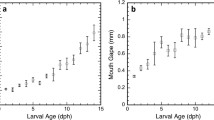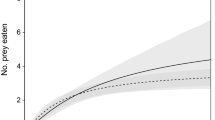Summary
-
1.
We describe a laboratory investigation to determine how the possession of egg sacs by a freshwater copepod influences the likelihood of its capture by both efficient (bream) and inefficient (roach) zooplanktonivorous fish.
-
2.
For both predators the reaction distance was greater for the larger, more visible ovigerous prey than for nonovigerous copepods.
-
3.
Copepods spent more time stationary, in contact with the substrate, when a fish was present. The more susceptible ovigerous individuals were generally less active than nonovigerous individuals even in the absence of predators. The likely adaptive significance of this behaviour in the natural environment is discussed.
-
4.
The inefficient zooplanktonivorous fish had a significantly increased attack efficiency on ovigerous prey because their egg sacs reduced acceleration and manoeuvrability. Attack efficiency was only marginally enhanced in the case of the more efficient predator.
-
5.
The energy value of ovigerous prey, expressed in terms of biomass consumed per unit handling time, was greater than for non-ovigerous individuals.
Similar content being viewed by others
References
Brooks JL, Dodson SI (1965) Predation, body size and composition of plankton. Science 150:28–35
Confer JL, Blades PI (1975) (a) Reaction distance to zooplankton by Lepomis gibbosus. Verh Int Verein Limnol 19:2493–2497
Confer JL, Blades PJ (1975) (b) Omnivorous zooplankton and planktivorous fish. Limnol Oceanogr 20:571–579
Confer JL, Howick GL, Corzette MH, Kramer SL, Fitzgibbon S, Landesberg R (1978) Visual predation by planktivores. Oikos 31:27–37
Drenner RW, Strickler R, O'Brien WJ (1978) Capture probability: The role of zooplankter escape in selective feeding of planktivorous fish. J Fish Res Board Can 35:1370–1373
Dumont HJ, Van de Velde I, Dumont S (1975) The dry weight estimate of biomass in a selection of Cladocera, Copepoda, and Rotifera from the plankton, periphyton and benthos of continental waters. Oecologia (Berlin) 19:75–97
Eggers DM (1977) The nature of prey selection by planktivorous fish. Ecology 58:46–59
Feifarek BP, Wyngaard GA, Allan JD (1983) The cost of reproduction in a freshwater copepod. Oecologia (Berlin) 56:166–168
Hall DJ, Threlkeld ST, Burns CW, Crowley PH (1976) The sizeefficiency hypothesis and the size structure of zooplankton communities. Ann Rev Ecol Syst 7:177–208
Hrbacek J (1962) Species composition and the amount of zooplankton in relation to fish stocks. Rozpr Cesk Akad Ved 72:1–116
Mellors WK (1975) Selective predation of ephippial Daphnia and the resistance of ephippial eggs to digestion. Ecology 56:974–980
O'Brien WJ, Slade NA, Vinyard GL (1976) Apparent size as the determinant of prey selection by bluegill sunfish (Lepomis macrochirus). Ecology 57:1304–1310
Sandstrom O (1980) Selective feeding by baltic herring. Hydrobiologia 69:199–207
Townsend CR, Hughes RN (1981) Maximising net energy returns from foraging. In: Townsend CR, Calow P (eds) Physiological ecology: an evolutionary approach to resource use. Blackwell Scientific Publications, Oxford, pp 86–108
Vuorinen I, Rajasilta M, Salo J (1983) Selective predation and habitat shift in a copepod species—support for the predation hypothesis. Oecologia (Berlin) 59:62–64
Wierzbicka M (1962) On the resting stage and mode of life of some species of Cyclopoida. Pol Arch Hydrobiol 10:215–229
Winfield IJ (1983) An experimental approach to the understanding of prey selection by young cyprinid fish. Proc 3rd Brit Freshw Fish Conf, pp 236–244
Winfield IJ, Peirson G, Cryer M, Townsend CR (1983) The behavioural basis of prey selection by underyearling bream (Abramis brama (L.)) and roach (Rutilus rutilus (L.)). Freshw Biol 13:139–149
Wright DI, O'Brien WJ (1982) Differential location of Chaoborus larvae and Daphnia by fish: the importance of motion and visible size. Am Midl Nat 108:68–73
Zaret TM, Kerfoot WC (1975) Fish predation on Bosmina longirostris: body-size selection versus visibility selection. Ecology 56:232–237
Zaret TM (1980) The effect of prey motion on planktivore choice. In: Kerfoot WC (ed) Evolution and ecology of zooplankton communities. University Press of New England, Hanover, New Hampshire USA, pp 594–603
Author information
Authors and Affiliations
Rights and permissions
About this article
Cite this article
Winfield, I.J., Townsend, C.R. The cost of copepod reproduction: increased susceptibility to fish predation. Oecologia 60, 406–411 (1983). https://doi.org/10.1007/BF00376860
Received:
Issue Date:
DOI: https://doi.org/10.1007/BF00376860




